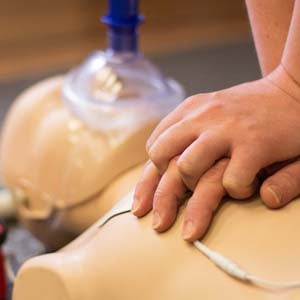Home / Safety & First Aid Courses / First Aid & CPR - An in Depth Guide to CPR, AED and Choking
1
/
of
1
First Aid & CPR - An in Depth Guide to CPR, AED and Choking
First Aid & CPR - An in Depth Guide to CPR, AED and Choking
Regular price
$149.00
Regular price
Sale price
$149.00
Unit price
/
per
Emergencies can strike unexpectedly, and being equipped with the knowledge and skills to respond promptly can mean the difference between life and death. Cardiovascular emergencies such as sudden cardiac arrest, choking incidents, and respiratory distress are among the most time-sensitive situations where immediate intervention can save lives. This in-depth guide to CPR, AED, and choking response aims to empower individuals with the essential skills and confidence needed to act decisively in critical situations.
Couldn't load pickup availability


Category: Safety & First Aid Courses
View full details

Description
Emergencies can strike unexpectedly, and being equipped with the knowledge and skills to respond promptly can mean the difference between life and death. Cardiovascular emergencies such as sudden cardiac arrest, choking incidents, and respiratory distress are among the most time-sensitive situations where immediate intervention can save lives. This in-depth guide to CPR, AED, and choking response aims to empower individuals with the essential skills and confidence needed to act decisively in critical situations.
Cardiopulmonary Resuscitation (CPR):
Cardiopulmonary resuscitation (CPR) is a lifesaving technique used to revive individuals who have experienced sudden cardiac arrest, where the heart has stopped beating effectively. CPR involves a combination of chest compressions and rescue breaths to circulate oxygenated blood to vital organs until professional medical help arrives. Here's an overview of the key steps in performing CPR:
Automated External Defibrillator (AED):
An automated external defibrillator (AED) is a portable device that delivers an electric shock to the heart to restore normal rhythm in cases of sudden cardiac arrest. AEDs are designed to be user-friendly and can significantly increase the chances of survival when used promptly. Here's how to use an AED effectively:
Choking Response:
Choking occurs when an object becomes lodged in the throat, obstructing the flow of air to the lungs. Prompt action is crucial to dislodging the obstruction and restoring normal breathing. Here's how to respond to a choking victim:
Cardiopulmonary Resuscitation (CPR):
Cardiopulmonary resuscitation (CPR) is a lifesaving technique used to revive individuals who have experienced sudden cardiac arrest, where the heart has stopped beating effectively. CPR involves a combination of chest compressions and rescue breaths to circulate oxygenated blood to vital organs until professional medical help arrives. Here's an overview of the key steps in performing CPR:
- Assess the Scene: Ensure the area is safe for you and the victim. Check for any hazards or dangers before approaching the individual.
- Check Responsiveness: Tap the victim gently and shout, "Are you okay?" If there is no response, call for help immediately and activate emergency medical services (EMS).
- Open the Airway: Place the victim on their back and tilt their head back gently to open the airway. Look, listen, and feel for signs of breathing.
- Perform Chest Compressions: Position yourself directly over the victim's chest and interlock your hands. Perform chest compressions at a rate of 100 to 120 compressions per minute, pressing down at least 2 inches in depth.
- Deliver Rescue Breaths: After 30 compressions, give two rescue breaths using a mouth-to-mouth or mouth-to-mask technique, ensuring proper seal and adequate breath volume.
- Continue CPR: Alternate between cycles of chest compressions and rescue breaths until help arrives or the victim shows signs of responsiveness.
Automated External Defibrillator (AED):
An automated external defibrillator (AED) is a portable device that delivers an electric shock to the heart to restore normal rhythm in cases of sudden cardiac arrest. AEDs are designed to be user-friendly and can significantly increase the chances of survival when used promptly. Here's how to use an AED effectively:
- Turn On the AED: Power on the device and follow the audio and visual prompts provided.
- Attach Electrode Pads: Place the electrode pads on the victim's bare chest as indicated by the AED. One pad should be placed on the upper right chest and the other on the lower left side of the chest.
- Analyze Heart Rhythm: The AED will analyze the victim's heart rhythm and determine if a shock is needed.
- Clear the Victim: Ensure no one is touching the victim and press the shock button if advised by the AED.
- Resume CPR: Immediately resume CPR following the AED prompts until emergency medical personnel arrive.
Choking Response:
Choking occurs when an object becomes lodged in the throat, obstructing the flow of air to the lungs. Prompt action is crucial to dislodging the obstruction and restoring normal breathing. Here's how to respond to a choking victim:
- Assess the Severity: Determine if the victim is able to speak, cough, or breathe. If the obstruction is partial, encourage the victim to continue coughing to expel the object.
- Perform Abdominal Thrusts (Heimlich Maneuver): Stand behind the victim and wrap your arms around their waist. Make a fist with one hand and place it above the navel, grasping it with the other hand. Perform quick upward thrusts into the abdomen until the object is expelled.
- Perform Back Blows: If the victim is unable to stand or cough effectively, perform back blows by delivering firm blows between the shoulder blades with the heel of your hand.
- Alternate Techniques: Continue alternating between abdominal thrusts and back blows until the obstruction is cleared or the victim becomes unconscious.

